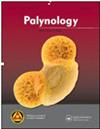Pollen Morphology of Endemic Linum Species (Linoideae: Linaceae) from Mexico
IF 1.3
4区 地球科学
Q3 PALEONTOLOGY
引用次数: 0
Abstract
ABSTRACT The morphological characteristics of pollen grains of Linum species in Mexico have not previously been evaluated in quantitative terms. This study reports statistical values of pollen characteristics – polar axis, equatorial axis, shape, polar area, exine thickness, sexine thickness, nexine thickness, and height and diameter of ornamental pollen elements – of 11 of the 13 endemic species accepted to date and for which material was available: L. cruciata, L. flagellare, L. lasiocarpum, L. longipes, L. mexicanum, L. modestum, L. orizabae, L. pringlei, L. rzedowskii, L. scabrellum, and L. tenellum. The detailed light and scanning electron microscopy study revealed that the pollen is prolate-spheroidal to subprolate, tricolpate and with semitectate exine sculptured with bacula, clavae, gemmae or spines whose height and diameter follow a homogeneous, intermediate, or heterogeneous pattern. The principal component analysis found that five characters, namely the height of the ornamental elements, sexine thickness, exine thickness, diameter of ornamental elements, and nexine thickness, explained the highest percentage of the variance between species. The cluster and discriminant analyses classified some of the species into three groups and differentiated three of them according to their morphology. The difficulty in distinguishing some species through a conventional approach was solved conveniently using palynological traits since the ornamentation pattern of pollen grains was unique and because grains of various species were statistically different, thus representing a tool for identifying Linum species.墨西哥特有亚麻属植物(亚麻科)的花粉形态学
摘要 以前从未对墨西哥亚麻属植物花粉粒的形态特征进行过定量评估。本研究报告了迄今为止已接受的 13 个地方物种中 11 个物种的花粉特征统计值,包括极轴、赤道轴、形状、极区、外轮廓厚度、性轴厚度、内轮廓厚度、观赏花粉元素的高度和直径:L. cruciata、L. flagellare、L. lasiocarpum、L. longipes、L. mexicanum、L. modestum、L. orizabae、L. pringlei、L. rzedowskii、L. scabrellum 和 L. tenellum。详细的光镜和扫描电子显微镜研究表明,花粉呈球状至近球状、三柱状,具有半ectate外皮,外皮上雕刻有bacula、clavae、gemae或刺,其高度和直径遵循同质、中间或异质模式。主成分分析发现,装饰要素的高度、sexine 厚度、exine 厚度、装饰要素的直径和 nexine 厚度这五个特征解释了物种间差异的最大百分比。聚类分析和判别分析将部分物种分为三组,并根据形态将其中三个物种区分开来。由于花粉粒的装饰图案是独一无二的,而且不同物种的花粉粒在统计学上存在差异,因此利用古植物学特征可以很方便地解决传统方法难以区分某些物种的问题,从而成为鉴别亚麻属植物物种的工具。
本文章由计算机程序翻译,如有差异,请以英文原文为准。
求助全文
约1分钟内获得全文
求助全文
来源期刊

Palynology
地学-古生物学
CiteScore
3.40
自引率
26.70%
发文量
48
审稿时长
>12 weeks
期刊介绍:
Palynology is an international journal, and covers all aspects of the science. We accept papers on both pre-Quaternary and Quaternary palynology and palaeobotany. Contributions on novel uses of palynology, review articles, book reviews, taxonomic studies and papers on methodology are all actively encouraged.
 求助内容:
求助内容: 应助结果提醒方式:
应助结果提醒方式:


